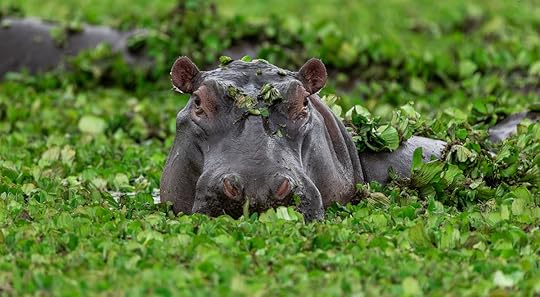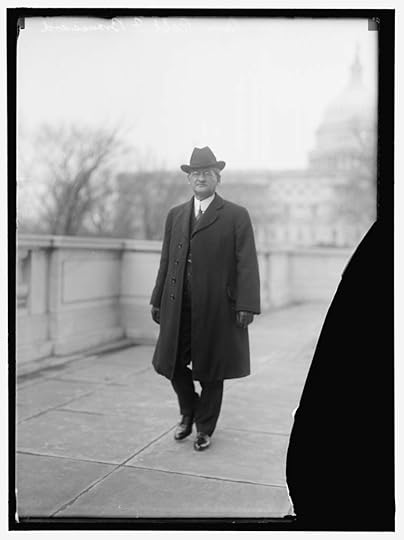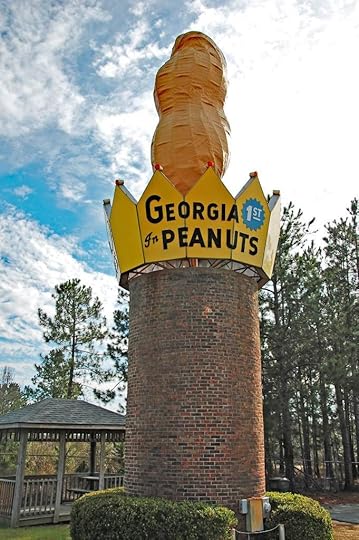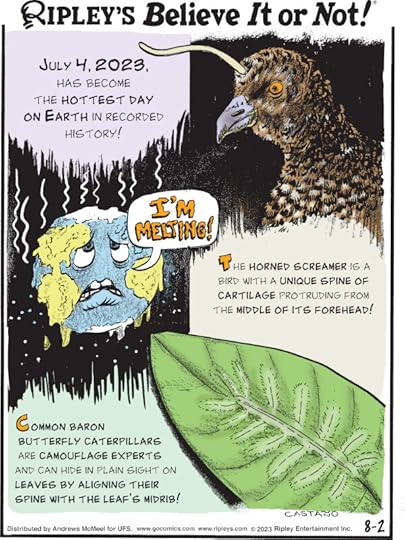Ripley Entertainment Inc.'s Blog, page 14
August 3, 2023
That Time The U.S. Tried To Make Hippo Farming Happen
Featured in Ripley's Believe It or Not!

The humble yet magnificent hippopotamus deserves acknowledgment. A big-ticket item in any safari trip or park visit, these salad-loving powerhouses are truly iconic. Such settings are the only places that many have ever seen hippos. But the United States could have been much more familiar with them. In fact, the country could have earned recognition for its hippo ranchers!
Meet The Potential Solution To The Meat ProblemIn the late 1800s and early 1900s, the United States was in the grip of two potentially devastating issues. The first, a food crisis brought about by a lack of access to meat. According to Portland State University’s Catherine McNeur, meat providers across the nation were accused by the people of “conspiring to profit at their expense.” During the same period, an elaborate plant, the water hyacinth, had relentlessly spread across the south after being introduced at the 1884 Cotton States Exposition. It grew faster than anyone could remove it, clogging up the waters in the process!
The United States entered the twentieth century with some unique dilemmas to resolve. However, one particularly large and meaty plant-eater comes to mind to devour those troublesome hyacinths. The curious thing is that hippos actually eat surprisingly little: Their daily (or rather nightly) diet of around 88 lbs of food is relatively modest for such a hefty creature: The largest male hippos can weigh almost 10,000 lbs!

Hippopotamus feeding on river bank. Credit: Shutterstock.
We don’t know if they would be particularly effective at devouring those plants. One thing however that’s difficult to deny is that a hippo has a tremendous amount of flesh. For these reasons, it seems, a United States-wide network of hippo ranches almost became a reality.
The very concept sounds outlandish, but there’s a strange kind of logic to it. As Jon Mooallem explained to WIRED, “The idea was that you could harness land that wasn’t productive for grazing cattle, like swamps and bayous. So you’d transplant the hippos into these environments that aren’t totally unlike where they live in Africa.” But how would the hippos have made it to the United States, and what was the plan for them from there?
Mass hippo importation from the creatures’ home continent was the plan.
The Hippo BillHouse Resolution 23261, more commonly known as the American Hippo Bill. The bill was brought to the House Committee on Agriculture in March of 1910. Advocating for it was Louisiana’s own Robert F. Broussard.
The title of the bill does not address the magnificent hippopotamus directly. Rather the wider issue of importing animals, both domestic and wild, into the United States. During the meeting, W.N. Irwin of the Department of Agriculture’s had some choice words. Irwin’s statement notes that “it seems rather strange that for four hundred years we have continued to use three animals for our meat supply – cattle, sheep, and swine.” For any nervous hippos reading this, yes, you can probably see where this is going, and you’re not going to like it.

Robert F. Broussard. Credit: Public Domain Wikimedia Commons.
Irwin went on to note that these were species imported from Europe, and that the price of meat had risen to such a degree that it wasn’t conceivable to meet the increased demand and ensure the people were fed. Irwin’s proposed solution to this issue? “… we get the hippopotamus here – an animal whose flesh is excellent in quality and that is easily kept in suitable locations.”
The vast land of the United States, as Mooallem reported, offers such locations, which would be entirely impractical for ranches for other species. Irwin even suggests the rhinoceros as another possible ranching candidate, as he claims the desert regions of the United States, harsh areas where few other species can thrive, would be suited to their needs.
Irwin went on to claim of the hippopotami that “the people who have handled them tell me they are very easily tamed, and become very much attached to man.” He did note that they had a tendency to travel far (15 miles overnight). According to him, though, fencing would allow them to be easily controlled. All in all, it seemed, the case was made. So-called “lake cow bacon” could have become as commonly consumed as … well, bacon.
The Flaws And Fate Of The Hippo PlanUltimately, though, the hippo-ranching dream would not become reality. A combination of factors would see the controversial bill fail to take off. There were a few dramatic holes in the logic. For one, Hippos and water hyacinths don’t totally mix. While they do consume plants that grow on the water, their preference is for grasses, and they can spend about five hours every day grazing on just that.
While we didn’t ultimately get to see exactly how this would happen, it seems clear that the hippos would have been unwilling to help much with the hyancinth problem. It’s very likely that the huge creatures would have proven far less pliant than Irwin boldly claimed they would. As long-roamers, it is unlikely that keeping large groups of them enclosed would have been a practical task.

Pontederia crassipes, commonly known as common water hyacinth. Credit: Shutterstock.
Nonetheless, there was some press support for the plan. A piece in the contemporary Lippincott’s Monthly Magazine, according to Mooallem in Atavist, dreamed of “that golden future when the meadows and the bayous of our Southern lands shall swarm with herds of hippopotami.”
How It All Played OutPolitical disagreements ultimately doomed the idea: Congress’s break was approaching, and the proponents of the New Food Society, a potential group that would be formed to make everything happen, struggled to collaborate to concentrate their efforts.
Amidst these troubles, the emergence of World War I and the global devastation it caused meant that other priorities would ultimately see the efforts fizzle out. The Hippo Bill remains one of the most peculiar “what ifs” in American history.
By Chris Littlechild, contributor for Ripleys.com
EXPLORE THE ODD IN PERSON! Discover hundreds of strange and unusual artifacts and get hands-on with unbelievable interactives when you visit a Ripley’s Odditorium!Source: That Time The U.S. Tried To Make Hippo Farming Happen
CARTOON 08-03-2023
August 2, 2023
Scientists Are Waking ‘Zombie Viruses’ From Their Permafrost Slumber
Featured in Ripley's Believe It or Not!

It’s the stuff of nightmares. As climate change accelerates, scientists are beginning to uncover ‘zombie viruses’ in the melting permafrost.
Although the name sounds terrifying, don’t panic just yet — the zombie apocalypse is not upon us. Viruses found in the Siberian permafrost – the permanently frozen layer of soil that isn’t supposed to thaw, even in summer – have been named “zombie viruses” because they were dormant (sort of “undead”), but scientists are now bringing them back to life.
In fact, scientists have already dusted off thirteen viruses from their icy sleep so far.
Pandoravirus Yedoma: The Granddaddy of ‘Zombie Viruses’Ever wondered what a 48,500-year-old virus looks like? Meet Pandoravirus yedoma – eerily named, of course, after Pandora’s Box – the oldest virus ever to wake up from its icy slumber.
Scientists found Pandoravirus yedoma under an icy lake in the Russian Far East in 2022. Pandoraviruses are the biggest viruses known, with a supersized DNA that contains up to 2,500 genes (compared with just ten genes in many viruses). Pandoravirus yedoma quickly woke up from its sleep when introduced to a one-cell organism, infecting it within minutes.
Pithovirus Sibericum: The Sleeping Giant AwakensIn 2000, researchers came across Pithovirus sibericum, snuggled deep within the permafrost of Kolyma, Russia. At around 1.5 micrometers (1000 times smaller than a millimeter) long, it might sound small. In the world of viruses, Pithovirus Sibericum is quite a giant.
After scientists found the 30,000-year-old virus, they introduced it to some amoebas — and the virus came back to life. But don’t worry just yet — for now Pithovirus Sibericum can only infect amoebas. Humans (and our furry friends) are off the menu.

Pithovirus sibericum sketch. Credit: Pavel Hrdlička Via Wikimedia Commons (CC BY-SA 3.0).
Scientists felt elated, as they had seen a virus that remained infectious for so long for the first time. But many more virus discoveries were soon to follow.
Mollivirus Sibericum: It’s a Small World After AllIt’s not the size that makes the virus, though. Discovered at the same time as P. sibericum, Mollivirus sibericum is a much smaller virus — but once it attacks an amoeba, it can produce 200 to 300 viral particles.
Again, don’t lose sleep over it. M. sibericum poses no threat to humans or other animals. But its discovery does make researchers wonder — what else is lurking in the Siberian wilderness?
It’s Getting Hot in HereWell, that’s a tricky question. Siberia is warming at nearly four times the global average rate and also experiencing intense wildfires. In July 2023 alone, “110 forest fires were raging across about 61,000 hectares, roughly three-quarters the size of New York City.”
The soaring temperatures are melting the region’s permafrost. As the ice melts, a Pandora’s box of ancient viruses is coming up to the surface.
While the viruses recovered so far can only infect amoebas, there’s no way to know what else is lurking in the ice — including viruses that could potentially jump to humans and animals.
Smallpox — which killed over 300 million people in the 20th century alone and was eradicated in 1980 — can survive freezing temperatures, so if scientists ever run into infected centuries-old human remains, it’s possible the virus could come back to life.
The scientists who studied Mollivirus sibericum believe the danger is real. In a 2015 study, they point out that while the viruses recovered so far can’t hurt us, “we cannot rule out that distant viruses of ancient Siberian human (or animal) populations could reemerge as arctic permafrost layers melt and/or are disrupted by industrial activities.”
So, while the term ‘zombie viruses’ may sound like something from a horror movie, the truth is that as our planet continues to warm, we must prepare for what we might unearth.
By Diana Bocco, contributor for Ripleys.com
EXPLORE THE ODD IN PERSON! Discover hundreds of strange and unusual artifacts and get hands-on with unbelievable interactives when you visit a Ripley’s Odditorium!Source: Scientists Are Waking ‘Zombie Viruses’ From Their Permafrost Slumber
CARTOON 08-02-2023
August 1, 2023
Ashburn, GA, Resurrects Big Peanut Roadside Attraction After Hurricane
Featured in Ripley's Believe It or Not!

Whether we’re talking Margate, New Jersey’s Lucy the Elephant, California’s Cabazon Dinosaurs, or Gold Hill’s Oregon Vortex, roadside attractions have decorated American roadscapes since the 1940s. A fun byproduct of interstate automobile travel, they’ve long invited on-the-go people to stop, take a pic, and buy something. Along the way, many became celebrated parts of Americana.
Yet, as early as the mid-1950s, many roadside attractions faced dilapidation as the U.S. Interstate Highway System bypassed their locations. Only the most eclectic and beloved survived the resulting traffic drought. These include the iconic Big Peanut along Interstate 75 in South Georgia. The pride of the state’s peanut belt, Hurricane Michael irreparably damaged the marvelous monument in October 2018.
But residents of its home base in Ashburn recently resurrected the Big Peanut. Back better than ever, it’s a sight to behold.
History of the Massive GooberMore than 50 percent of the United States’ peanut production comes from Georgia. In 2022, this accounted for a whopping 2.9 billion pounds of goobers. So, a giant roadside attraction shaped like a peanut was a natural expression of this industry.
It also acted as an enticement to visitors, inviting them to pull off the road in the small town of Ashburn. One that even big names like Mila Kunis and Ashton Kutcher have proven unable to resist!

Credit: Jud McCranie Via Wikimedia Commons (CC BY-SA 4.0).
But a giant nut crafted from fiberglass couldn’t withstand the 110-mile-per-hour winds that rocked parts of the Southeastern United States during Hurricane Michael. Long story short, it blew away faster than Dorothy’s house in Kansas.
Although the Florida Panhandle took the brunt of the hurricane’s onslaught, the storm spawned destructive tornadoes that ravaged neighboring parts of Georgia. In the Category 5 storm’s aftermath, residents of Ashburn awoke to the horror of a landscape devoid of its legume landmark.
The Big Peanut RebornNearly five years later, however, the Big Peanut’s back better than ever. The 9,000 residents of Ashburn-Turner County raised $80,000 for the rebuild. Ultimately, $70,000 went into the project, with $10,000 set aside for future maintenance.
This time, the gargantuan nut is immortalized in sheet metal. Residents of Ashburn hope the landmark will remain large and in charge for decades to come.
Speaking on behalf of the Ashburn-Turner County Chamber of Commerce, Ashley Miller sees the Big Peanut as far more than a roadside attraction. “I think it represents home.” Moreover, she feels it’s the perfect way to commemorate the Georgia farmers who fuel America’s peanut industry.
Besides choosing a sturdier material for the quirky attraction, community leaders used the rebuild to add a few additional improvements. These include LED lights to illuminate the structure at night. The inner workings of the peanut are also reinforced with a metal pole and interior framework.
A Homage to AmericaApart from the money needed for the project, laborers put in serious time. All told, between 700 and 800 laborer hours went into the structure, which stands 40 feet tall from its base to the top of the peanut. The landmark weighs 5,000 pounds!
What does the future look like for Ashburn’s Big Peanut? Local officials plan on creating a welcoming “selfie spot” for passersby. That way, road trippers will enjoy the best angles when snapping selfies with the immense nut.
Ready for your visit to the Big Peanut? Or maybe you’d like to undertake a larger all-American road trip around some of the nation’s most eclectic roadside attractions? Check out our list of the zaniest thoroughfare hotspots in the U.S.
Then, head to your nearest Ripley’s Attraction, where you’ll find fun and fresh nods to the masterpieces of the American roadside. From the sinking Titanic in Panama City Beach, Florida, to Hollywood’s T. Rex, these head turners are just the beginning when it comes to discovering a world of wonder.
By Engrid Barnett, contributor for Ripleys.com
EXPLORE THE ODD IN PERSON! Discover hundreds of strange and unusual artifacts and get hands-on with unbelievable interactives when you visit a Ripley’s Odditorium!Source: Ashburn, GA, Resurrects Big Peanut Roadside Attraction After Hurricane
CARTOON 08-01-2023
July 31, 2023
CARTOON 07-31-2023
July 30, 2023
CARTOON 07-30-2023
July 29, 2023
CARTOON 07-29-2023
July 28, 2023
Up Close & Peculiar: Diving Into Dinosaur Discoveries
Featured in Ripley's Believe It or Not!

Today: Dinosaurs
Hello everyone! Today is a little different because we are taking a look at a huge piece! This is a section, mostly the tail and part of the spine, of a hadrosaurid, or a duck-billed dinosaur. I genuinely cannot believe this is a real thing that I’m looking at. If just the tail is this big, I cannot even imagine how big the whole dino was!
As if standing in front of a twenty-foot dinosaur tail wasn’t cool enough, what’s even cooler about this piece is that there is actually mummified skin and tendons on this thing, as you can see here! Finding soft tissue preserved like this is unbelievably rare.
We can tell a little bit more about this dino’s story by looking at what paleontologists believe are bite marks or scars, which tell us that the tail was being used defensively, or even that a T-Rex might have bitten it off in the heat of a battle!
Staying in the world of dinosaurs, I also have with me these dino footprints! We don’t know exactly what type of dinosaur left these tracks, but I feel like these kind of look like prehistoric chicken feet, except this chicken would definitely eat me for dinner instead of the other way around!
Would you have liked to have met these dinosaurs? Let us know in the comments and I’ll see you next time!
EXPLORE THE ODD IN PERSON! Discover hundreds of strange and unusual artifacts and get hands-on with unbelievable interactives when you visit a Ripley’s Odditorium!Source: Up Close & Peculiar: Diving Into Dinosaur Discoveries
Ripley Entertainment Inc.'s Blog
- Ripley Entertainment Inc.'s profile
- 52 followers









